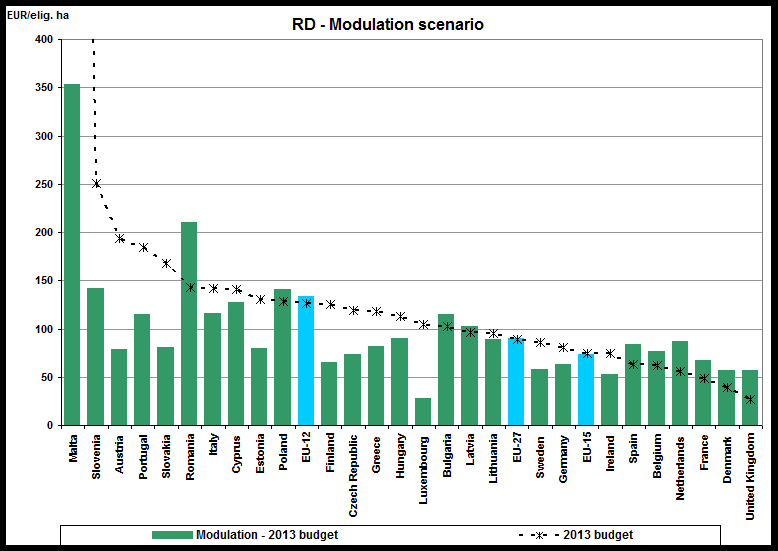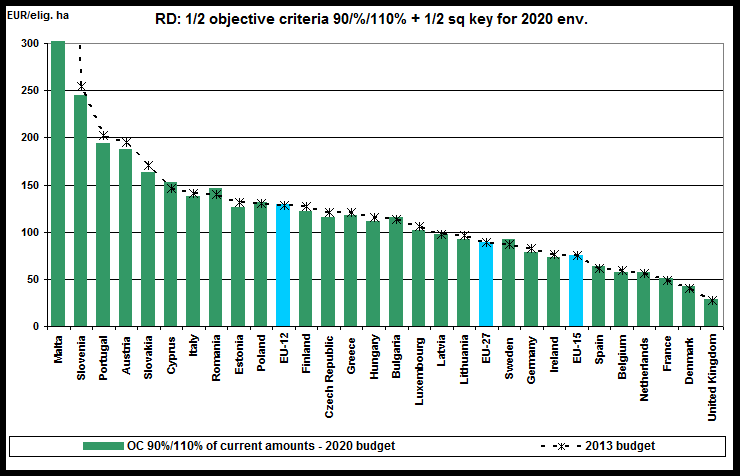The early September draft of the Commission legislative proposal for the new Rural Development regulation to be released on October 12th next was inconclusive on how Pillar 2 spending would be allocated across the Member States. The annual amounts available to each member state will not be determined in the Regulation, but will be left to a subsequent Commission implementing act, taking into account (a) objective criteria linked to the three objectives of the Regulation (agricultural competitiveness, sustainable land management and balanced territorial development) and (b) past performance.
The draft impact assessment on the new regulation which also has yet to be formally released provides some further guidance on the Commission’s thinking, and shows how the distribution across member states would be affected by the use of different objective criteria. The simulations show how judicious selection of the criteria can almost exactly reproduce the status quo!
Various options are considered in the impact assessment. The first is distribution according to the so-called modulation formula used to distribute the additional resources made available through modulation to the member states. This formula is
(0.65 Area + 0.35 Labour) x GDP inverse index.
The resulting share out of funds compared to the current (2013) distribution is shown in the first figure.

A second option is to come up with a new formula using criteria related to the future policy objectives weighed on the basis of their importance in the policy design. For the integration scenario (which is the scenario proposed in the draft Regulation), possible objective economic criteria include agricultural area and labour force as indicators of the size of the agricultural sector and labour productivity as an indicator of the extent to which the sector is lagging behind.
Possible objective environmental criteria include agricultural area, Natura 2000, NHA, forest and permanent pasture areas as indicators of the public goods provided. Work on climate change vulnerability indicators is still ongoing and hence such indicators cannot be used.
For the territorial balance objective, possible objective indicators include rural population as an indicator of the target group benefiting from the support while the extent to which rural areas are lagging behind is covered by the use of a GDP coefficient for the whole formula. To take account of the cohesion objective, the whole formula is calibrated by GDP/capita in PPS (the lower the GDP in the MS, the higher the MS envelope).
The specific formula examined is
[1/3 [(½ Area + ½ Labour) x labour productivity inverse index] + 1/3 (1/3 NHA area + 1/3 Natura 2000 + 1/6 Forest + 1/6 Permanent pasture) + 1/3 Rural population] x GDP inverse index
The resulting share out of funds as compared to the current (2013) distribution is shown in the second figure.

The results of both of these options differ considerably from the current distribution. So the impact assessment goes on to consider ways to smooth out the impact of redistribution. It identifies a number of ways that the current distribution may be taken into account:
- by distributing 50% of the total envelope on the basis of the current distribution key and 50% on the basis of the new distribution key (transfers from the market remain exempted from the redistribution)
- by providing that no MS should end up with less than 90% and not more than 110% of its current envelope
- by providing for a transitional period gradually moving towards the new distribution
- for the small Member States (LU, MT) an ad hoc solution would in any case be required.

By applying these criteria, we could actually manage to reproduce the current distribution as is shown in the figure above! I draw the conclusion that so-called ‘objective criteria’ are far from objective and in fact are highly political. Leaving the resolution of this issue to a Commission implementing act to be adopted under the examination procedure seems much more likely to succeed that leaving it to the Council and Parliament to agree at the third reading in the conciliation committee. Wise move!

